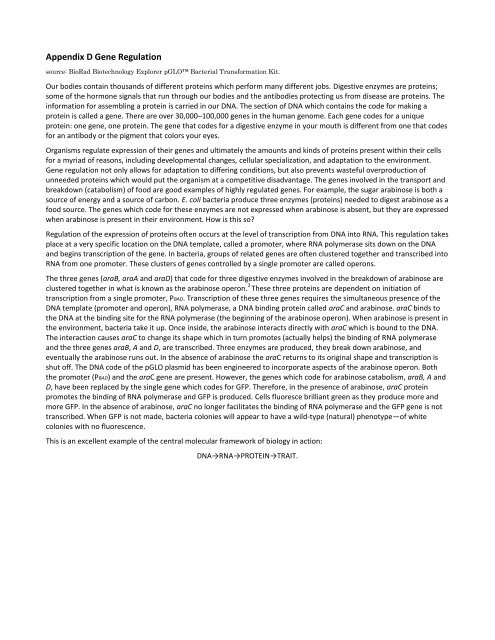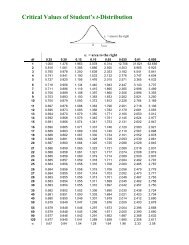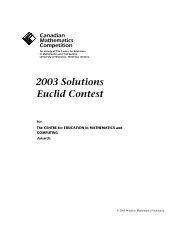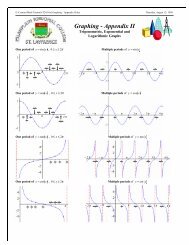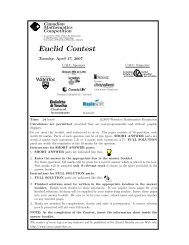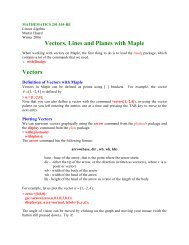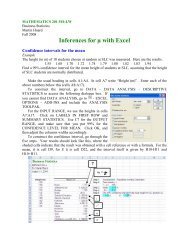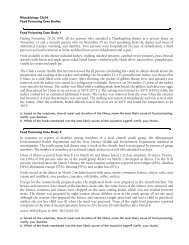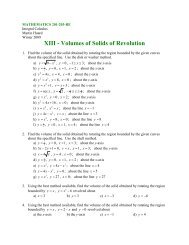Appendix D Gene Regulation - SLC Home Page
Appendix D Gene Regulation - SLC Home Page
Appendix D Gene Regulation - SLC Home Page
Create successful ePaper yourself
Turn your PDF publications into a flip-book with our unique Google optimized e-Paper software.
<strong>Appendix</strong> D <strong>Gene</strong> <strong>Regulation</strong><br />
source: BioRad Biotechnology Explorer pGLO Bacterial Transformation Kit.<br />
Our bodies contain thousands of different proteins which perform many different jobs. Digestive enzymes are proteins;<br />
some of the hormone signals that run through our bodies and the antibodies protecting us from disease are proteins. The<br />
information for assembling a protein is carried in our DNA. The section of DNA which contains the code for making a<br />
protein is called a gene. There are over 30,000–100,000 genes in the human genome. Each gene codes for a unique<br />
protein: one gene, one protein. The gene that codes for a digestive enzyme in your mouth is different from one that codes<br />
for an antibody or the pigment that colors your eyes.<br />
Organisms regulate expression of their genes and ultimately the amounts and kinds of proteins present within their cells<br />
for a myriad of reasons, including developmental changes, cellular specialization, and adaptation to the environment.<br />
<strong>Gene</strong> regulation not only allows for adaptation to differing conditions, but also prevents wasteful overproduction of<br />
unneeded proteins which would put the organism at a competitive disadvantage. The genes involved in the transport and<br />
breakdown (catabolism) of food are good examples of highly regulated genes. For example, the sugar arabinose is both a<br />
source of energy and a source of carbon. E. coli bacteria produce three enzymes (proteins) needed to digest arabinose as a<br />
food source. The genes which code for these enzymes are not expressed when arabinose is absent, but they are expressed<br />
when arabinose is present in their environment. How is this so?<br />
<strong>Regulation</strong> of the expression of proteins often occurs at the level of transcription from DNA into RNA. This regulation takes<br />
place at a very specific location on the DNA template, called a promoter, where RNA polymerase sits down on the DNA<br />
and begins transcription of the gene. In bacteria, groups of related genes are often clustered together and transcribed into<br />
RNA from one promoter. These clusters of genes controlled by a single promoter are called operons.<br />
The three genes (araB, araA and araD) that code for three digestive enzymes involved in the breakdown of arabinose are<br />
clustered together in what is known as the arabinose operon. 3 These three proteins are dependent on initiation of<br />
transcription from a single promoter, PBAD. Transcription of these three genes requires the simultaneous presence of the<br />
DNA template (promoter and operon), RNA polymerase, a DNA binding protein called araC and arabinose. araC binds to<br />
the DNA at the binding site for the RNA polymerase (the beginning of the arabinose operon). When arabinose is present in<br />
the environment, bacteria take it up. Once inside, the arabinose interacts directly with araC which is bound to the DNA.<br />
The interaction causes araC to change its shape which in turn promotes (actually helps) the binding of RNA polymerase<br />
and the three genes araB, A and D, are transcribed. Three enzymes are produced, they break down arabinose, and<br />
eventually the arabinose runs out. In the absence of arabinose the araC returns to its original shape and transcription is<br />
shut off. The DNA code of the pGLO plasmid has been engineered to incorporate aspects of the arabinose operon. Both<br />
the promoter (PBAD) and the araC gene are present. However, the genes which code for arabinose catabolism, araB, A and<br />
D, have been replaced by the single gene which codes for GFP. Therefore, in the presence of arabinose, araC protein<br />
promotes the binding of RNA polymerase and GFP is produced. Cells fluoresce brilliant green as they produce more and<br />
more GFP. In the absence of arabinose, araC no longer facilitates the binding of RNA polymerase and the GFP gene is not<br />
transcribed. When GFP is not made, bacteria colonies will appear to have a wild-type (natural) phenotype—of white<br />
colonies with no fluorescence.<br />
This is an excellent example of the central molecular framework of biology in action:<br />
DNA→RNA→PROTEIN→TRAIT.
References<br />
1. Hanahan, Douglas, Studies on transformation of Escherichia coli with plasmids. J. Mol. Biol., 166, 557 (1983).<br />
2. Hanahan, Douglas, Techniques for transformation of E. coli. In DNA Cloning: A Practical Approach (Ed. D. M. Glover), vol. 1. IRL Press,<br />
Oxford (1987).<br />
3. Schleif, Robert,Two positively regulated systems, ara and mal, In Escherichia coli and Salmonella, Cellular and Molecular Biology,<br />
Neidhardt. ASM Press, Washington, D.C. (1996).


